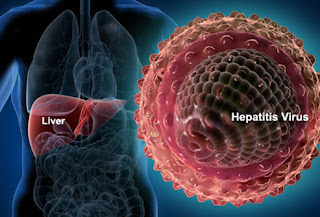hepatitis virus
Society has been looking at HIV as the most
dangerous virus in the world. No wonder if all the power is deployed to combat
the virus. But it turns out hepatitis B is much more dangerous than HIV. The
high risk of hepatitis B infection even reached 100 times than the virus causes
the aids.
The spread of hepatitis B is increasingly
vulnerable in endemic countries. Recorded World Health Organization (WHO), from
6 billion of the earth's population, 2 billion of them or as much as 30 percent
positive infected with hepatitis B. And based on the map of the spread of
hepatitis B made by WHO also, Indonesia including countries with moderate to
high infections.
The rate of hepatitis B infection is stated
low if only diidap less than 2 percent of the population. Being between 2-8
percent and if more than 8 percent, it means the spread of hepatitis B virus
somewhere is high.
"In Indonesia, for areas in Java Island
infected with Hepatitis B below 8 percent, but for outside Java reaches more
than 8 percent.That is why Indonesia entered the country endemi hepatitis B is
high to high," said the expert in internal medicine and consultants
digestion and liver From RSUP Kariadi Semarang, Dr. Hery Djagat Purnomo SpPD.
To prove more realistic about the spread of
hepatitis B in Indonesia, in 2007 the Ministry of Health conducted basic health
research involving 10 thousand samples. As a result, 9.4 percent of the samples
were positively infected with hepatitis B.
Given the dangers posed by hepatitis B,
Indonesia and Brazil also pioneered the hepatitis B infection care movement so
it was determined that July 28 is the day of hepatitis B worldwide. It is
expected that public awareness of the danger of this disease also increases.
So, what makes this virus so dangerous? Dr
Hery Djagat reveals among others because the distribution is very high, while
we do not know anyone around us who suffer from hepatitis B. Patients themselves
are often not aware that they are already infected. This is very dangerous
because the worst effects of this virus can lead to liver cancer.
Given the heart is one of the most vital
organs possessed by humans with the primary function of filtering toxins in the
body, you can imagine what happens if the heart is damaged.
Transmission or transmission of hepatitis
itself is divided into two vertical transmission and horizontal transmission.
Vertical transmission occurs when a mother is suffering from hepatitis B so
that at the time of delivery it is very likely to be transmitted to the child.
"This is the most common type of transmission, so in Indonesia, every
newborn baby should get anti-hepatitis injections," explains Dr. Hery
Djagat.
While horizontal transmission is the
transmission that occurs between people with people through the media such as
blood transfusion, syringes used more than one person, and sexual intercourse.
Based on the amount of viral load and the
ability to channel, the highest risk is blood transmission either transfusion,
syringe or open wound. The moderate is the transmission through semen / vagina
(during intercourse) and saliva or saliva.
What also has the potential to transmit
hepatitis B is sweat, milk and tears. It's just that the potential is very
small. "For that, in conducting blood transfusion, the use of needles in
need of sex especially out of wedlock and others need to be careful," said
Dr. Hery Djagat. Msi





No comments:
Post a Comment